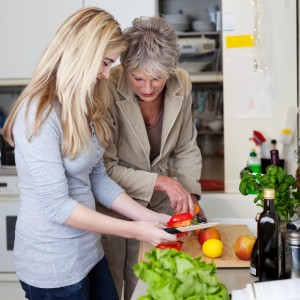10/21/14
People cook for different reasons. Some just so they can eat, others enjoy the creativity and find it relaxing and for some it is a activity they have fun doing with others. But cooking can become difficult and dangerous as you lose your vision. Here are some useful tips to help keep you safe and give you confidence to enjoy cooking with low vision.

1. To avoid burns, place a pot or pan on the burner before turning it on and, turn the burner off before removing the pot or pan.
2. Turn pan handles inward from the stove or counter to avoid spills and burns.
3. Mark common or often used settings on appliances with bright nail polish, bright colored tape, or raised dots.
4. Purchase a microwave with a sensor reheat feature to automatically reheat food to the proper temperature.
5. Use long oven mitts to protect your hands and arms from hot surfaces.
6. Turn on the oven light while using it to remind you the oven is on.
7. Use a double spatula to help avoid spills when turning food.
8. Use a special measuring cup that enhances contrast.
9. Use a knife with an adjustable slicing guide.
10. Have light and dark cutting boards to be able to provide the most contrast depending on what you are slicing or chopping – such as black for slicing onions and white for chopping kale.
11. Use a large print, low-vision kitchen timer.
12. Use an automated coffee maker that makes a single cup of coffee or tea to eliminate the need to pour boiling liquids and risk burns.
13. Attach low-glare fluorescent lighting to the underside of cabinets to make it easier to see.
14. Outline the end of countertops with colored duct tape, or paint in a color that contrasts with the work surface. Also choose kitchenware that contrast with the countertop.
15. Organize shelves in a logical way, possibly alphabetically, with most use items easily accessible. Be sure to return items to where they were originally.
16. Use a color for the interior of cupboards that contrasts with your dishes to make them easier to see. Do not use clear glasses or dishes as they appear invisible.
17. If you have glaucoma and experience tunnel vision, remove cabinet doors or replace with sliding doors.
18. Place rubber bands around the milk carton to distinguish it from the orange juice carton. This also works well with distinguishing a can of chicken noodle soup from tomato, etc.
19. Avoid overflows by hooking a “liquid Level” indicator to your glass or cup that will play a tune when you are ¾” from the top.
20. For cold drinks you can also use your finger by placing the tip of it over the edge of the glass and stop pouring when you feel the liquid.
Once you have prepared your food, eating can also be a challenge, so here are five bonus tips.
1. Use dinner plates with a raised lip to avoid spills or pushing the food off while eating.
2. Avoid patterns on dinnerware.
3. Make sure your dishes contrast with the table or table linens.
4. Have a system for putting food on your plate such as meat at 6:00, vegetables at 3:00 and starches at 9:00.
5. Use a gooseneck lamp directly over you plate.


